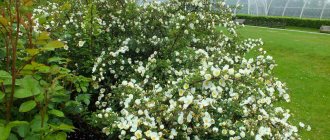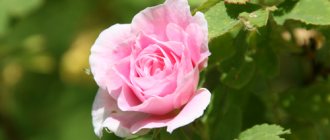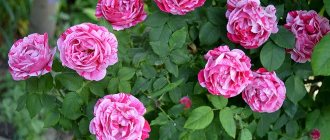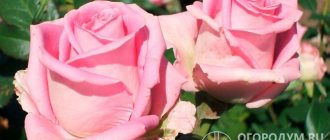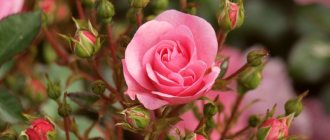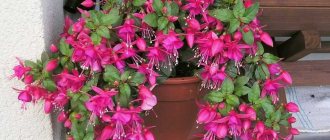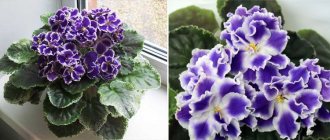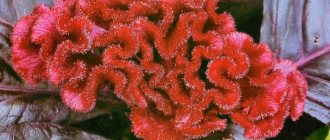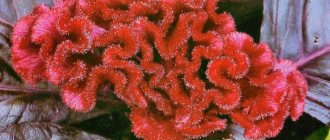Rose “John Davis” is another winter-hardy masterpiece of Canadian breeders, included, along with the popular variety “Alexander Mackenzie” and others, in the “Explorer” collection series. It stoically endures the harsh Canadian and Russian winters with their especially low temperatures, and also successfully adapts to the hot, dry climate of the southern regions. This Kordesii hybrid perfectly combines the appearance of ancient roses with the vitality of the best modern specimens.
"John Davis" is a gardening variety that can be grown as a spreading shrub or a small climber
Description of the John Davis rose variety and characteristics
It is a shrub with long climbing shoots. The height of John Davis roses reaches 2 m. The plant quickly grows in width - up to 2.5 m.
Annual growth of bushes – up to 40 cm
In the first 1-2 years, the shoots are short and erect, which is why the John Davis rose looks like a standard one. Subsequently, the stems begin to bend towards the ground. To maintain the neat shape of the bush, a garter to the trellis is required.
The shoots are strong, elastic with dark green bark, and are not prone to lignification. There are practically no large thorns on the stems. The foliage is dense, lush, along the entire length of the shoots. The plates are oval, 5-6 cm long, with jagged edges. The leaves are matte, rich green.
The budding period begins in mid-to-late May and continues throughout June. The John Davis variety begins to bloom in the first month of summer. The buds open quickly and gradually fade by mid-July.
The plant blooms very profusely, continuously. Inflorescences of 10-15 buds are formed on the stems. The flowers are densely double, round, hemispherical in shape, with 50-60 petals. Color – bright pink. The aroma is pleasant, strongly pronounced even from a distance.
John Davis rose flowers fade in the sun and turn ashen
Important! Due to its sensitivity to light, it is recommended to plant the variety in partial shade.
The John Davis variety is characterized by high cold resistance. The plant tolerates frosts down to -29 degrees. In the south and regions of central Russia, there is no need to cover bushes for the winter. Such measures are necessary only in Siberia and the Urals, where the temperature in winter is constantly negative.
John Davis rose bushes remain decorative until mid-autumn. In October, the foliage on the bushes begins to fade, resulting in bare stems.
The variety does not tolerate drought well. This is explained by the large number of leaves, which quickly evaporate moisture in the summer. Overwatering can also harm bushes, especially when soil compacts near the roots.
John Davis roses are disease resistant. The risk of developing powdery mildew and black spot exists only with high humidity or during drought.
Bloom
The park rose is characterized by continuous abundant flowering. The first buds bloom in the second decade of June, and the last flowers remain until October, and with the age of the bush, flowering becomes more abundant, and the life cycle of flowers increases. In the southern regions, the plant blooms earlier - by the end of May.
The dense, bright red, conical bud with a pointed apex slowly opens, taking on the appearance of an antique rose, the inner petals of which are folded in the shape of a tulip. At the next stage of dissolution, the middle of the flower becomes quartered, and a fully blossomed double rose, consisting of 30-40 petals, takes on a cup-shaped shape and can reach a diameter of 7-9 cm.
When fully bloomed, the flowers have an attractive center with golden-yellow stamens.
The petals are dense, satiny, wide-rounded, with a carved edge. At the beginning of dissolution, they have a rich pink color, but gradually fade, acquiring creamy shades at the base. The edges of the outer petals bend slightly outward, which gives the flower additional splendor, while the inner petals remain slightly curved towards the center.
The variety is characterized by a delicate, unobtrusive fruity aroma with light spicy notes.
Advantages and disadvantages
John Davis is recognized as one of Canada's best park varieties. The plant has many advantages over other species.
Among the main advantages:
- very abundant flowering;
- low demands on soil composition;
- good winter hardiness;
- rapid growth of shoots;
- low sensitivity to infections;
- Possibility of growing as an ampelous plant.
Variety John Davis does not require formative pruning
The plant has several disadvantages. This should definitely be taken into account when planting this variety in the garden.
Main disadvantages:
- low drought resistance;
- possibility of damage to pests;
- need for garter;
- relatively short flowering period.
Another disadvantage is the presence of small thorns. When working with the plant, precautions must be taken.
Origin
The variety was bred in the 70s of the last century by the famous Canadian breeder, Dr. Felicitas Svejda. Obtained by pollinating a second generation hybrid seedling of kordesii with pollen from the Canadian hybrid: Red Dawn (Robert Simonet, 1957) x Suzanne (Dr. Frank Leith Skinner, 1950). Belongs to the group of Canadian Hardy Roses - park varieties created specifically for decorative landscaping in harsh conditions.
John Davis is a descendant of the hybrid Cordes rose (Rosa kordesii Hort.), which inherited exceptional hardiness from wild species
The name of the variety is given in honor of the famous English traveler, corsair, explorer, inventor and cartographer - Lord John Davis (1550-1605).
In 2000, John Davis won the international competition of the American Rose Society (ARS) Mid-Hudson Rose Society Show.
Reproduction methods
Bushes over 3 years old can be divided. You need to select one young stem, remove it from the trellis, dig up the rose and separate the shoot with its roots. In the future, plant the resulting division in a new place, after soaking it in an antiseptic. In this case, the stem needs to be trimmed, leaving 8-12 cm to speed up rooting.
Division is carried out in spring or autumn after flowering.
John Davis roses have long and resilient shoots. Therefore, this variety is convenient to propagate by layering. You need to select 1 stem, remove it from the trellis and bend it to the ground. It is sprinkled with nutritious soil and watered. After 4-5 weeks, roots appear on the shoot. It is separated from the mother bush and planted in a new place.
Adult bushes can also be propagated by cuttings. Shoots with 2-3 buds and several leaves are harvested as planting material. It is recommended to root them in a container with soil and then plant them in open ground in the fall.
Growing a flower, how to plant it correctly in open ground
Tractor John Deere 8430: characteristics and features
To grow a beautiful and healthy bush, you need to take the most responsible approach to choosing planting material.
In what form is planting carried out (seeds, seedlings, etc.)
Planting directly into the ground is carried out exclusively with seedlings. You can grow them yourself from seeds or purchase them in specialized stores.
The optimal age at which planting can be done is two years.
Remember! An adult bush does not take root well and is more capricious to external conditions.
What time does boarding take place?
Planting in open ground should be carried out only after the soil has completely warmed up. The optimal temperature is +10 degrees. The best period for planting is April-May.
Preparing roses for planting in open ground
Attention! In the first year after planting, roses should not be allowed to bloom. Some gardeners also plant in the fall
In this case, it is important not to be late
The plant must have time to take root before severe frosts. Some gardeners also plant in the fall
In this case, it is important not to be late. The plant must have time to take root before severe frosts.
Some gardeners also plant in the fall
In this case, it is important not to be late. The plant must have time to take root before severe frosts. Some gardeners also plant in the fall
Some gardeners also plant in the fall
In this case, it is important not to be late. The plant must have time to take root before severe frosts.
Selecting a location
The planting area should be illuminated most of the day. But at the same time it is necessary to protect the bush during the sunniest hours. You can use fabrics to create shade.
The proximity of groundwater is undesirable.
How to prepare the soil and flower for planting
Before planting or replanting any plant on the site, the following preparatory measures are required:
- All weeds are removed.
- The earth is being dug up.
- If the soil is acidic, it is necessary to normalize the pH with lime.
- Before planting, the roots are soaked in warm water for 2-3 hours.
- Damaged roots must be cut off and treated with any stimulant.
The culture requires a high-quality fertile substrate
Step by step landing procedure
Roses are endowed with a well-developed root system. Therefore, the holes for planting shrubs should be large, at least 60 cm deep, 1 m wide. The bottom is drained with any available material: brick, pebbles.
The fertile substrate must be prepared in advance. To do this, mix the following ingredients: chernozem - 5 l, 2 tbsp. bone meal and 0.5 tbsp. superphosphate. This mixture is poured over the drainage and fertile soil is poured on top. After planting the bush, the soil is compacted and thoroughly watered.
Planting a plant in the ground
Attention! Mulching is a great way to maintain the necessary soil moisture for a long time.
Growing and caring for Canadian park rose John Davis
It is recommended to plant in the fall so that the seedling is well rooted before the onset of cold weather. If you plant a bush in the spring, a lot of nutrients will be spent on shoot growth and foliage formation.
For park rose John Davis, places with partial shade are best suited. It will develop worse in the shade.
Important! The plant is best planted near a fence or other structure that will serve as a support.
The area for the rose is prepared in advance. Remove weeds, dig up the soil, apply fertilizer. The bush requires a planting hole 60-70 cm deep and a similar width. Expanded clay or crushed stone must be placed at the bottom to drain liquid.
The seedling is placed in a planting hole with a depth of 4-5 cm
The roots of the plant should be covered with a loose soil mixture of garden soil, turf, river sand, compost and peat. After planting, the seedling is watered. If necessary, a support is immediately installed nearby.
Caring for a John Davis rose involves the following activities:
- Regular watering, 1-2 times a week, as the soil dries out.
- Loosening the soil around the bush 1-2 times a month to a depth of 10-12 cm.
- Mulching the soil with bark, sawdust or peat.
- Sanitary pruning in the fall to remove faded flowers and foliage.
- Hilling up the lower part of the shoots to protect against overheating.
The John Davis variety responds positively to fertilizing. In spring and when buds appear, nitrogen solutions are added. When flowering, fertilizers with potassium and phosphorus are recommended. In the fall, a complex composition is given in combination with humus or compost.
Preparation for winter involves removing shoots from the trellis. The stems need to be carefully twisted and placed at the base of the bush. To protect them from frost, the shoots are covered with dry leaves and covered with spruce branches.
Care instructions
This variety, like other types of park roses, is not particularly demanding in care. Feed the plant periodically. Its composition is as follows:
- 20 g of saltpeter with ammonia;
- 30 g superphosphates;
- 10 g potassium salt;
- 10 liters of water.
5 liters of fertilizer must be poured under one bush. Then irrigate generously.
Rose Cordes diamond
Important! While the leaves on the bush are blooming, you should also feed the plant with fermented mullein.
During the period of bud formation, water no more than 3 liters per plant with superphosphate solution:
- 10 liters of water;
- 30 g superphosphates.
As buds begin to form and flower, care must be taken to ensure regular watering. It is recommended to do it in the evening. In hotter periods, increase the liquid flow and watering time several times. It is advisable to moisten the soil to half a meter. In the autumn, watering should be done as needed;
With the arrival of spring, it is necessary to remove dried and diseased branches.
Pests and diseases
The John Davis variety exhibits resistance to many infections. But the risk of infection cannot be completely eliminated, especially if the rules for caring for park roses are not followed.
Possible diseases include:
- powdery mildew;
- rust;
- bacterial cancer;
- black spot;
- bark burn.
To prevent diseases, it is necessary to spray the rose with a fungicide 2-3 times a year. Be sure to carry out processing in the fall.
Important! Fungicide should be sprayed not only on the bush, but also on the soil around it.
Pests of climbing roses:
- spider mite;
- aphid;
- thrips;
- cicadas;
- pennies;
- leaf rollers.
It is advisable to use a liquid soap solution against insects. 200 g of grated laundry soap are diluted in 10 liters of warm water. Spray the rose with this product. The solution repels insects.
If damaged by insects, the bush should be sprayed with an insecticide.
Special drugs act quickly. 2-3 treatments are enough to get rid of insects.
Reviews from gardeners
Zhanna, 47 years old, Moscow
The rose winters well, I have no shelter: it is impossible to bend the thick, prickly stems to the ground, but this is not required. In the spring I fertilize with rotted manure and special compounds for roses, in August with ready-made complexes for feeding the root system, in September I give phosphate fertilizers, and in October I add humus and wood ash.
Irina, 51 years old, Vologda
The bush pleases with abundant flowering in the first wave at the beginning of summer; later in the season it blooms moderately. There is practically no smell. The roses are small, cute, and last quite a long time. Rain often ruins their appearance. The main advantage of the variety is frost resistance.
Alexandra, 35 years old, Nizhnevartovsk
Taking into account our frosts down to minus 40, I planted several varieties of Canadian roses. We survived two winters safely under spruce branches and cardboard. Even if they sometimes freeze slightly, they quickly recover in the spring. Now, in the third season, they bloom especially beautifully. The bushes do not grow as large as the descriptions indicate. Probably they just can’t keep up with the short and cool summer. They delight not only with flowers, but also with abundant, bright green, shiny foliage. They are very impressive to everyone who sees them.
Application in landscape design
The John Davis variety is used for vertical gardening. Planting several bushes in a row allows you to create hedges 2 m or more in height. In such plantings you can use John Davis roses, as well as other park climbing varieties.
When creating compositions, the plant should be given a central place. It is recommended to plant flowers and shrubs nearby that are undemanding in terms of soil composition and lighting.
Astilbe, sage, juniper, and lupins are good neighbors. You can plant armeria and carnations.
Important! Crops with fast-growing, climbing vine-like shoots should not be planted next to John Davis roses.
Landscape flower beds are created in the form of natural thickets. They can be supplemented with John Davis roses in combination with other low-growing varieties.
Personal life
Cabot, John
Rhys-Davies married Suzanne Wilkinson in December 1966. They had two sons. Although they separated in 1985, they remained married until her death in 2010 from Alzheimer's disease. He stayed by her side and took care of her until she died.
In 2004, he began living with Lisa Manning. They have a daughter and live between Waikato in New Zealand and the Isle of Man.
Religious views
Rhys-Davies is a self-proclaimed "rationalist" and "skeptic" when it comes to religion, although he has a high regard for Christianity and has stated that "Christian civilization has left the world a better place than ever before []. »
He played roles in several Christian films, including Mordecai in One Night with the King
, Saint Peter in
Peter the Apostle: Redemption
, Evangelist in
The Pilgrim's Progress
(2019), and Charles Kemp in
Behind the Mask
.
Political Views
Rhys-Davies at an autograph signing in Sweden
Rhys-Davies is not a member of any political party. As a university student in the 1960s, he was a radical leftist, but changed his views when he began criticizing Margaret Thatcher. Rhys-Davies says that "she shot down the first two bullies so brilliantly that I decided I should shut up and listen this time."
In 2004, Rhys-Davies stated the following in an interview with World
magazine about the Muslim population, stating:
His comments were supported by the British National Party. Rhys-Davies commented that the BNP were so small in numbers that they "could do no harm", but stated that it was "not pleasant to be on a BNP leaflet". He was also endorsed in an editorial by the National Vanguard. In an interview with the conservative magazine National Review
he said he opposes Islamic extremism precisely because he believes it violates “Western values” of equality, democracy, tolerance and the abolition of slavery.
Rhys-Davies is a Brexiteer.
